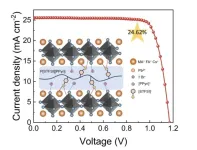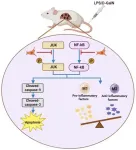(Press-News.org) Americans have gotten used to seeing their doctors and other health care providers using telehealth video visits in the past four years. But a new study reveals that what a doctor has behind them during a telehealth visit can make a difference in how the patient feels about them and their care.
Even if the doctor is miles away from their usual in-person clinic or exam room, they should make it look like they’re there, the study suggests.
Even better: sitting in an office with their diplomas hanging behind them – or perhaps having a virtual background that’s a photo of such an office. This is especially true if they haven’t seen the patient before, the study shows.
A home office with a bookshelf or a plain solid-color background are both acceptable to patients, too.
But providers should use blurred or virtual backgrounds if they carry out the visit in a home environment with a kitchen or a bed in the background, the study shows.
The findings come from a survey that asked patients to react to seven different backgrounds behind a model physician, and to rate how knowledgeable, trustworthy, caring, approachable and professional the physician appeared in each, and how comfortable the patient would feel with that provider. It also asked them to consider each background for a first or returning appointment with a primary care or specialty provider.
The study is published in JAMA Network Open by a team from the University of Michigan’s academic medical center, Michigan Medicine, and the VA Ann Arbor Healthcare System. More than 1,200 patients who had seen providers at one of the two health systems completed the study surveys, and the researchers compiled their responses.
Lead researcher Nathan Houchens, M.D., is an associate professor of internal medicine at U-M and associate chief of medicine at VAAAHS. His past work on how interpersonal communications affects the patient-provider relationship – including non-verbal factors like attire and posture – led to the new telehealth study.
“The transition to virtual care was rapid and came without specific guidance during the start of the COVID-19 pandemic, but telehealth appears to be here to stay so it’s important to understand what patients prefer when it comes to the setting their provider is in,” says Houchens, a hospitalist who worked with U-M and VA general internist Jennifer Meddings, M.D., M.Sc. and others on the study.
He notes that during the first year of the pandemic, providers were urged to conduct telehealth visits outside of clinics if they didn’t need to go in, to reduce the chance of COVID-19 transmission.
But now, some clinics have created dedicated spaces for providers to sit in if they have telehealth appointments on days when they’re also seeing patients in person. Some of those might be spaces shared with other clinicians, so a virtual background would also serve to reduce visual distractions.
Houchens notes that as telehealth increased in use and became a standard way to receive care, some guidance on “webside manner” has been suggested to guide providers in the ways in which they interact verbally over a virtual connection. But very little guidance is available about the background for their video visits.
He and his colleagues were surprised at the level of dislike that patients had for kitchen and bedroom settings, with only 2% and 3.5% saying they preferred these backgrounds respectively, compared with 35% for an office with displayed diplomas, 18% for a physician office, 14% for a plain color background, and around the same for a home office with bookshelf or an exam room.
There were also significant differences in the composite scores for how patients rated the way each background would make them feel about receiving care from the provider. The bedroom and kitchen backgrounds received far lower composite scores than any of the other five backgrounds.
Houchens and colleagues including co-author Sanjay Saint, M.D., M.P.H., have previously published work on patients’ preferences for what physicians wear during clinical encounters. Just like with video visit background, these seemingly superficial factors can actually make a difference in the patient experience, he says.
“Patients have expectations of what physicians’ attire and workspaces should look like. This study showed that patients prefer what have been previously termed traditional or professional attire and settings,” he said. “Diplomas and credentials remind patients of the expertise they expect a physician to have, and conversely, something is lost when the background conveys a relaxed, informal home environment.”
The team is currently analyzing more data from the same study, to assess other factors that affect patients’ telehealth experiences – including their access to high-speed internet and their ability to use necessary technologies.
But for now, they suggest that providers can take immediate steps to conduct virtual visits from an office or exam room. Clinics may want to make unused clinical rooms available for use by providers conducting virtual visits during in-person clinic days.
Another option is to create virtual backgrounds that will evoke these types of professional settings.
Houchens also notes that while they haven’t yet studied what physicians think of the backgrounds behind patients during video visits, these may provide helpful information.
The rise of “Hospital at Home” and home-based primary care means that patients with more acute conditions may be able to see their providers virtually, and that their setting can give clues to the way physical and social factors play a role in their health. Discussing visible elements from both a provider’s and a patient’s virtual background – art and other hobby-related items, for example – can also help build rapport, Houchens notes.
“This is a reminder that patients often do care about some of the details that providers and health systems may not have emphasized,” he said. “It’s important to remember that our words and our nonverbal behaviors are taken to heart by those we care for, and it behooves us to care about them as well.”
Meddings and Saint are members of the VA Center for Clinical Management Research and the U-M Institute for Healthcare Policy and Innovation.
In addition to Houchens, Meddings and Saint, the study’s authors are Latoya Kuhn MPH, David Ratz MS, Jason M. Engle MPH of VA CCMR.
Citation: Patient Preferences for Telemedicine Video Backgrounds, JAMA Network Open, doi:10.1001/jamanetworkopen.2024.11512
END
The doctor is in…. but what’s behind them?
Telehealth lets patients see doctors wherever they are, but a new study shows that a professional-looking backdrop matters
2024-05-15
ELSE PRESS RELEASES FROM THIS DATE:
Structural evolution and high-temperature sensing performance of polymer-derived SiAlBCN ceramics
2024-05-15
The group of Gang Shao from Zhengzhou University, China recently investigated the structural evolution of pentagonal polymer-derived SiAlBCN ceramics (PDCs) and outlined PDC-based sensor technology for high-temperature extreme environments. The high-performance temperature sensing materials including high sensitivity, fast response, wide detection range are scarce and needful. This research developed a ceramic-based temperature with attractive performance that can be applied in high-temperature environments ...
An environmental CGE model of China’s economy: Modeling choices and application
2024-05-15
The general equilibrium framework of the CGE model widely used in cost-benefit analysis in the field of energy and environmental policy. Based on standard micro- and macroeconomic theories, the CGE model establishes quantitative connections between various sectors of the economy, enabling the examination of both direct and indirect effects resulting from exogenous changes in the economy, as well as their global impacts on the overall economy.
A team of energy economists by Yu Liu from Peking University in Beijing, China recently outlined the detailed content of their CGE model. This model is constructed based on the CGE model theory of the Australian Center ...
Adding polymerized ionic liquid improves performance of perovskite solar cells
2024-05-15
Perovskite solar cells, which use materials with the same crystal structure as perovskite, are lightweight, flexible, easy to manufacture, and inexpensive. They can be attached to many different surfaces and are a promising technology. However, current perovskite solar cells are not durable, and they tend to be inefficient. New research shows how additive engineering with a polymerized ionic liquid to the metal halide perovskite material can improve the solar cell’s function, helping to pave the way for the future wide adoption of perovskite solar ...
Half-matched family donors offer best outcomes for Hispanic patients undergoing bone marrow transplants
2024-05-15
LOS ANGELES — For adults with acute lymphoblastic leukemia (ALL), a type of cancer that originates in the bone marrow, allogeneic stem cell transplantation (more commonly known as a bone marrow transplant) may be necessary for survival. But for Hispanic patients, finding an identically matched donor within their family or through the bone marrow donor registry can be challenging, with only a 30% chance of finding a matching relative and a 48% chance of identifying a matching bone marrow donor through the national donor registry.
However, a new Keck Medicine of USC study in Leukemia ...
Alzheimer’s disease without symptoms. How is that possible?
2024-05-15
Everyone experiences aging in their own way, and factors such as genetics, lifestyle and environment play a role in this process. Some individuals reach the age of 90 or even 100 in good health, without medications or brain disease. But how do these individuals maintain their health as they age?
Luuk de Vries from Joost Verhaagen's group, and his colleagues Dick Swaab and Inge Huitinga, looked at brains from the Netherlands Brain Bank. The Netherlands Brain Bank stores brain tissue from more than 5,000 deceased brain donors with a wide range of different brain diseases. What makes the Netherlands Brain Bank so unique is that, in addition to the stored tissue with very precise ...
Mesenchymal stem cells alleviate acute liver failure through regulating hepatocyte apoptosis and macrophage polarization
2024-05-15
Background and Aims
Acute liver failure (ALF) is a life-threatening clinical problem with limited treatment options. Administration of human umbilical cord mesenchymal stem cells (hUC-MSCs) may be a promising approach for ALF. This study aimed to explore the role of hUC-MSCs in the treatment of ALF and the underlying mechanisms.
Methods
A mouse model of ALF was induced by lipopolysaccharide and d-galactosamine administration. The therapeutic effects of hUC-MSCs were evaluated by assessing serum enzyme activity, histological appearance, and cell apoptosis in liver tissues. The apoptosis ...
Avian flu detected in New York City wild birds
2024-05-15
Washington, D.C.— May 15, 2024—A small number of New York City wild birds carry highly pathogenic H5N1 avian influenza, according to a recent study published in the Journal of Virology, a journal of the American Society for Microbiology. The work highlights that the interface between animals and humans that may give rise to zoonotic infections or even pandemics is not limited to rural environments and commercial poultry operations, but extends into urban centers.
“To my knowledge, this is the first large-scale U.S. study of avian influenza in an urban area, and the first with active ...
New campaign aims to empower Asian American communities with lifesaving CPR skills
2024-05-15
DALLAS, May 15, 2024 — Despite strides in cardiopulmonary resuscitation (CPR) training, consumer research from the American Heart Association reveals only 1 in 4 Asian American individuals are confident they could correctly perform Hands-Only CPR, compared with a comparable confidence rate of more 1/3 of the general population. The same survey showed nearly 70% of Asian American adults are hesitant to perform Hands-Only CPR because they are worried they will hurt the person who has suffered ...
Repurposed beer yeast may offer a cost-effective way to remove lead from water
2024-05-15
CAMBRIDGE, MA – Every year, beer breweries generate and discard thousands of tons of surplus yeast. Researchers from MIT and Georgia Tech have now come up with a way to repurpose that yeast to absorb lead from contaminated water.
Through a process called biosorption, yeast can quickly absorb even trace amounts of lead and other heavy metals from water. The researchers showed that they could package the yeast inside hydrogel capsules to create a filter that removes lead from water. Because the yeast cells are encapsulated, they can be easily removed from the water once it’s ready ...
NFCR CEO Dr. Sujuan Ba honored at AAPI Women's Gala 2024
2024-05-15
The National Foundation for Cancer Research proudly announces that our CEO, Dr. Sujuan Ba, was honored as one of the AAPI Women Leaders at the AAPI Women's Gala 2024 on May 14th in New York City. This prestigious event was hosted by The Serica Initiative to spotlight the outstanding achievements and contributions of Asian American and Pacific Islander (AAPI) women who are breaking barriers and making impacts in many sectors, enriching and adding value to our society.
This 8th year's gala, themed "Resilience and Perseverance," honored Dr. Ba for her exemplary leadership at NFCR and other organizations she is part of and her ...
LAST 30 PRESS RELEASES:
Why a life-threatening sedative is being prescribed more often for seniors
Findings suggest that certain medications for Type 2 diabetes reduce risk of dementia
UC Riverside scientists win 2025 Buchalter Cosmology Prize
SETI Institute opens call for nominations for the 2026 Tarter Award
Novel theranostic model shows curative potential for gastric and pancreatic tumors
How beige fat keeps blood pressure in check
Fossils reveal ‘latitudinal traps’ that increased extinction risk for marine species
Review: The opportunities and risks of AI in mental health research and care
New map reveals features of Antarctic’s ice-covered landscape
Beige fat promotes healthy vascular function and blood pressure in mice
Chronic low-dose pesticide exposure reduces the life span of wild lake fish, China-based study shows
Tiny earthquakes reveal hidden faults under Northern California
Long-term pesticide exposure accelerates aging and shortens lifespan in fish
Professor Tae-Woo Lee's research group develops groundbreaking perovskite display technology demonstrating the highest efficiency and industry-level operational lifetime
The “broker” family helps tidy up the cell
Ecology: Mummified cheetahs discovery gives hope for species’ Arabic reintroduction
Researchers survey the ADHD coaching boom
Air pollution and cardiac remodeling and function in patients with breast cancer
Risk of suicide in patients with traumatic injuries
Post–intensive care syndrome
The lifesaving potential of opioid abatement funds
The Frontiers of Knowledge Award goes to Allan MacDonald and Pablo Jarillo-Herrero for their discovery of the “magic angle” enabling science to transform and control the behavior of new materials
Discovery reveals how keto diet can prevent seizures when drugs fail
JMIR Publications and Sikt announce pilot flat-fee unlimited open access partnership
Finding new cell markers to track the most aggressive breast cancer in blood
A new, cleaner way to make this common fertilizer
Fire-safe all-solid-state batteries move closer to commercialization
Disinfecting drinking water produces potentially toxic byproducts — new AI model is helping to identify them
Unplanned cesarean deliveries linked to higher risk of acute psychological stress after childbirth
Healthy aging 2026: fresh pork in plant-forward diets supported strength and brain-health biomarkers in older adults
[Press-News.org] The doctor is in…. but what’s behind them?Telehealth lets patients see doctors wherever they are, but a new study shows that a professional-looking backdrop matters




